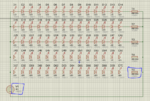Xenobius
Member level 5

Hi, this is a question about driving 140x LEDs which are rated from 3.2 to 3.6v and upto 700mA current (link for them here)
My design: I was thinking of using 24v to power 7x in series bringing the voltage down to 3.43v on each LED and I think this is fine.
My application: This is a Dual Sided PCB exposure box complete with vacuum. So there will be 70 leds on each side. And I might switch on the bottom, the top or both at any time. Also based on assumption and on other projects I found, with that much power it might take a maximum of 30 seconds to expose a full board.
My questions:
How would you do this assuming that you need 70x leds on each side? I am happy to wait 1 minute to be fair instead of 30 seconds but again I cannot know until I try. I may be wrong and will need 2 minutes who knows.
Thanks for reading
My design: I was thinking of using 24v to power 7x in series bringing the voltage down to 3.43v on each LED and I think this is fine.
My application: This is a Dual Sided PCB exposure box complete with vacuum. So there will be 70 leds on each side. And I might switch on the bottom, the top or both at any time. Also based on assumption and on other projects I found, with that much power it might take a maximum of 30 seconds to expose a full board.
My questions:
- Is it correct that I will need 45.5AMP per side to drive 70x @ 650mA? I mean the math is correct but is there a better way to drive an LED?
- With regards to limiting the current, I am only familiar with putting a resistor in series... is there a better way for example limit the current for all 7 leds in series in such a way that I do not waste so much power in heat?
How would you do this assuming that you need 70x leds on each side? I am happy to wait 1 minute to be fair instead of 30 seconds but again I cannot know until I try. I may be wrong and will need 2 minutes who knows.
Thanks for reading


